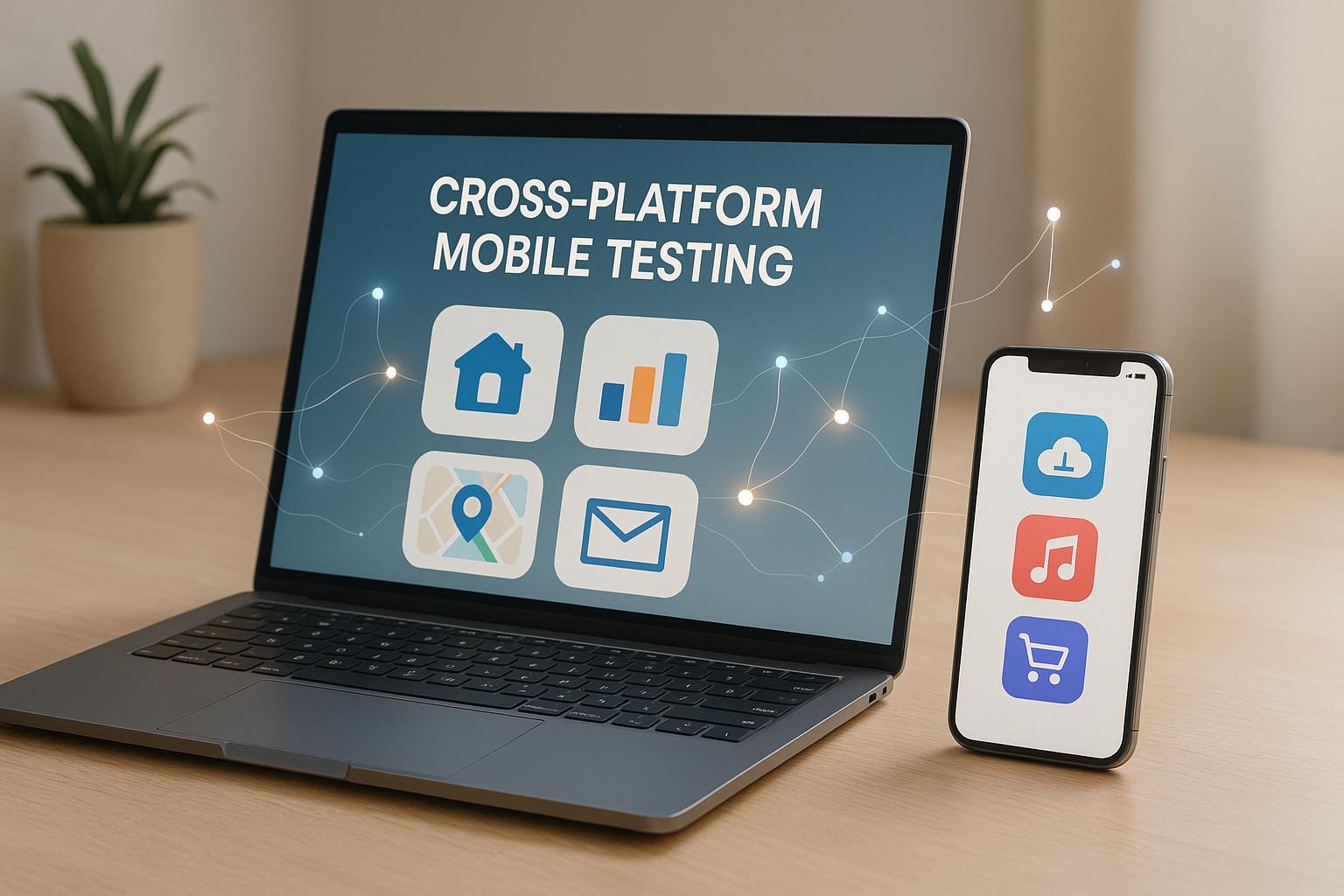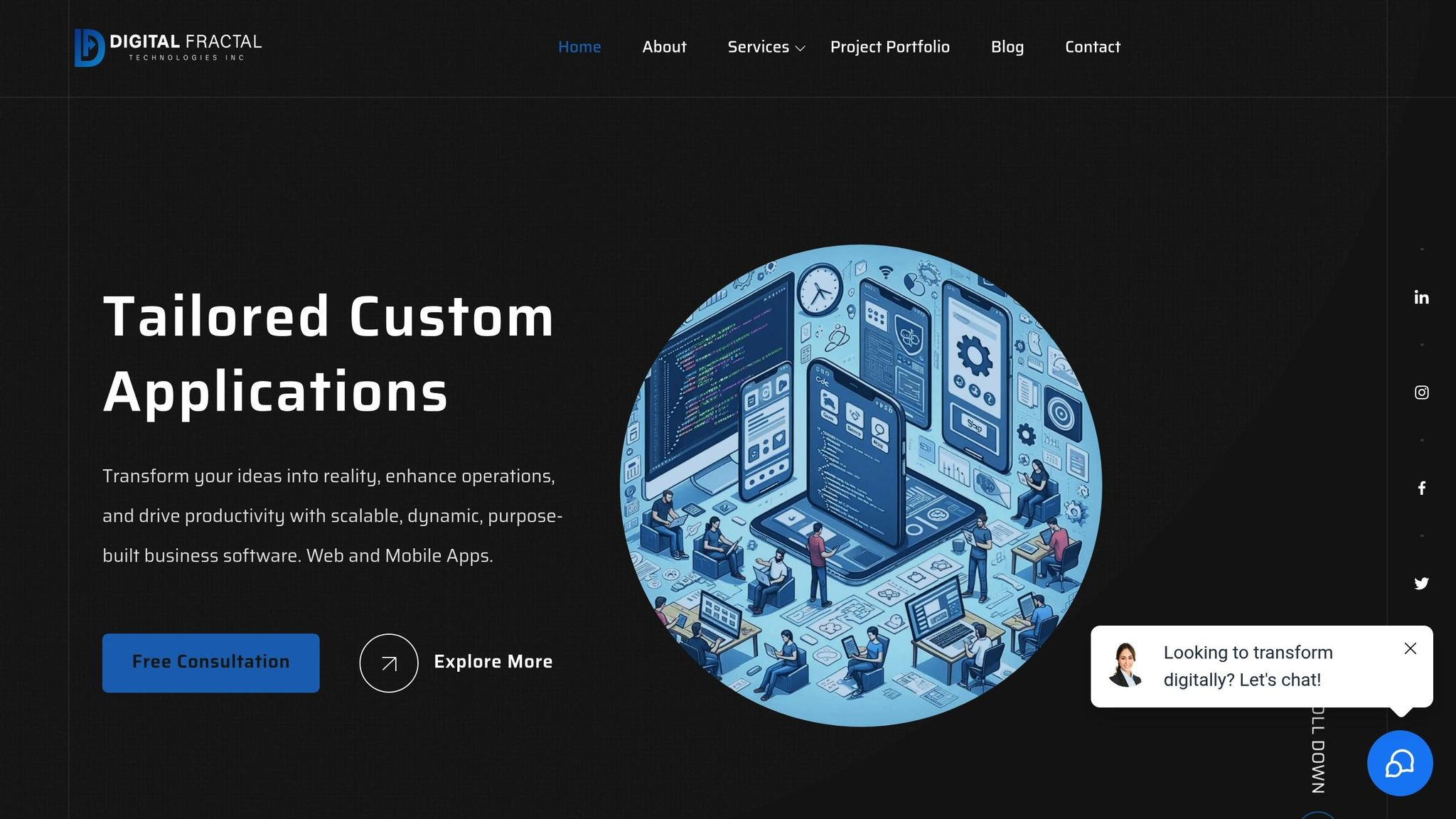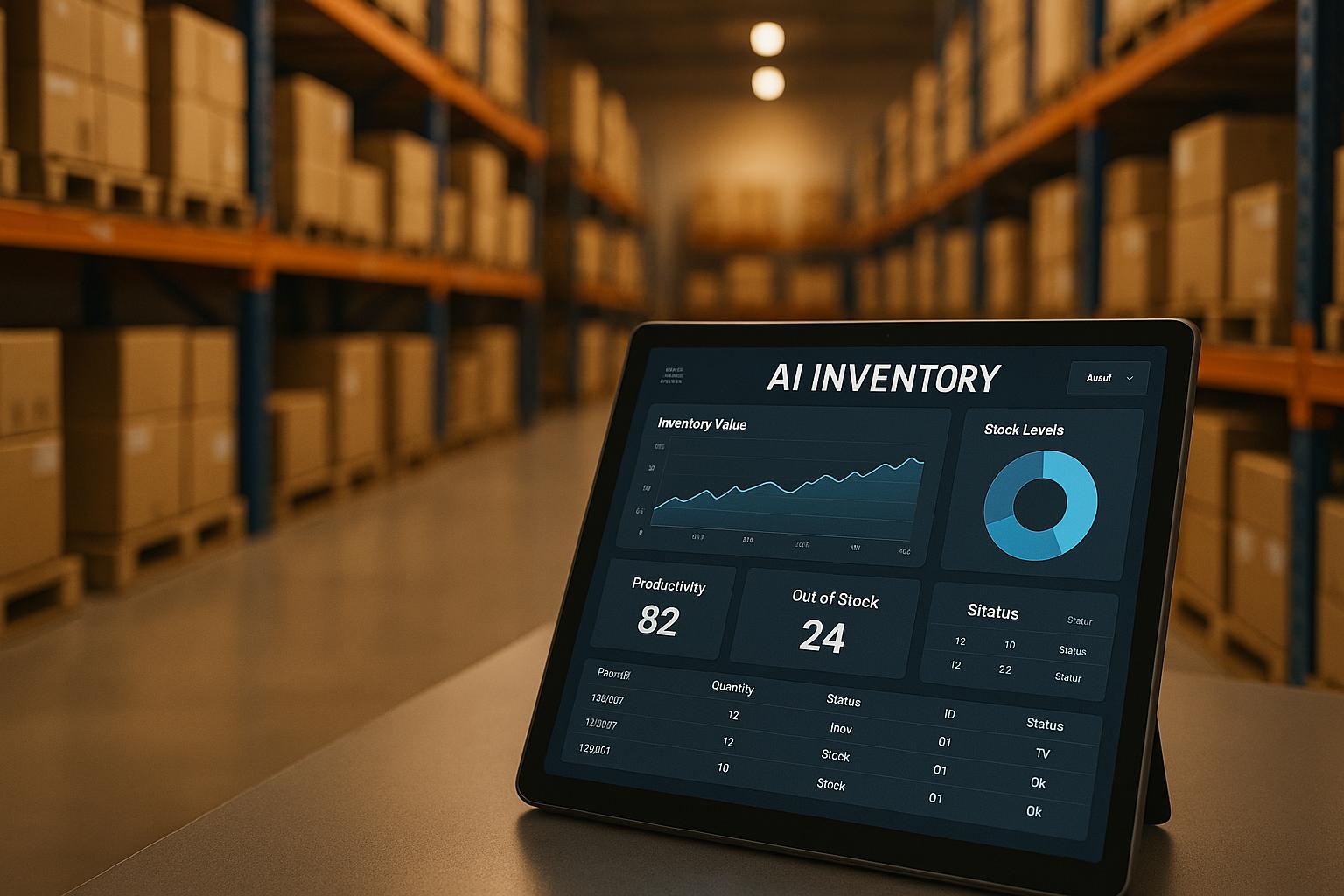
How AI Improves Cross-Platform Mobile Testing
Cross-platform mobile testing ensures apps work smoothly across devices, operating systems, and screen sizes. AI simplifies this process by automating repetitive tasks, predicting bugs, and adapting to changes. For Canadian businesses, AI also addresses bilingual (English/French) testing challenges and compliance with local regulations.
Key Highlights:
- AI Automation: Automatically generates and updates test scripts, saving time and reducing errors.
- Predictive Analytics: Identifies potential bugs before release by analyzing historical data.
- Self-Healing Tests: Adjusts to UI changes without manual intervention, ensuring continuous testing.
- Visual AI Testing: Detects interface issues, ensuring consistent layouts across devices and languages.
- Canadian-Specific Features: Tests for bilingual functionality, accessibility standards, and regional formats (e.g., CAD $, DD/MM/YYYY).
AI testing tools help Canadian organizations improve app reliability, reduce costs, and meet user expectations. Whether you’re in public services, energy, or tech, AI testing ensures your apps perform well in diverse conditions.
Leveraging AI for Mobile App Testing on Real Devices
Using Predictive Analytics to Find Bugs
Predictive analytics is changing the way development teams tackle bug detection. Instead of waiting for issues to surface during testing or, worse, after deployment, AI systems dive into historical data to predict where problems are most likely to pop up. This shift makes testing a strategic tool rather than just a reactive process. Armed with these insights, teams can fine-tune automated testing to focus on high-risk areas.
How AI Predicts Bugs Before Release
AI takes bug detection to the next level by using predictive analytics to flag potential issues before an application even launches. By examining historical data, these systems identify patterns that hint at vulnerabilities. Factors like code complexity, recent updates, developer activity, and device-specific behaviours are analysed to build risk profiles for different parts of the application.
Machine learning plays a big role here, uncovering connections that human testers might overlook. For instance, it can detect recurring glitches tied to specific user interface elements or coding habits that cause performance hiccups on certain devices.
AI doesn’t stop at just one data source – it pulls from multiple streams. It looks at past bug reports, recent code changes, and device usage patterns to create a detailed risk map. For apps that need to work across a variety of devices, predictive analytics even accounts for device fragmentation, helping to anticipate compatibility issues. And for bilingual apps, this approach ensures that both language versions are tested thoroughly.
While early versions of these systems might not be perfect, they get better with time. As more data flows in, the AI refines its predictions, making it increasingly reliable at identifying the conditions that lead to bugs.
Reducing Post-Release Problems
By addressing potential issues before launch, predictive analytics significantly cuts down on post-release headaches. Catching bugs early means fewer emergency fixes, which not only saves money but also helps maintain user trust. Apps that work well from day one are more likely to earn positive reviews and keep users engaged.
This approach also helps teams use their testing resources more wisely. Instead of spreading their efforts thin by testing every feature equally, they can zero in on the areas flagged as high risk. This targeted testing uncovers critical issues without adding to the overall workload.
For Canadian developers, predictive analytics can even factor in regional differences, like variations in connectivity or device preferences. This ensures that less common configurations, which might otherwise be overlooked, get the attention they need.
Over time, these predictive insights fine-tune testing strategies, leading to fewer bugs and smoother releases.
AI-Powered Test Automation
Test automation has long been a key part of efficient mobile app development, but AI is changing the game. With AI, test script creation and maintenance are now automated, freeing development teams to focus on creating better features while ensuring tests run smoothly across platforms and devices. This builds on earlier predictive capabilities, taking automation to a whole new level.
What makes AI stand out is its ability to adapt without human intervention. When developers update an app or change its interface, traditional automated tests often fail and require manual fixes. AI-powered systems, however, adjust automatically, ensuring the testing process continues seamlessly as the app evolves.
Automated Test Script Creation and Updates
AI is transforming how test scripts are created and updated by analysing existing code and user interactions. It studies app behaviour, identifies key user paths, and generates scripts that cover everything from common scenarios to edge cases.
When apps are updated, AI systems automatically revise the relevant test scripts. They monitor code changes, pinpoint which tests are impacted, and adjust them accordingly. This eliminates the delays caused by manual updates, keeping tests relevant and effective.
For cross-platform mobile apps, this automation is especially valuable. AI generates platform-specific variations of tests, accounting for differences in how iOS and Android handle features. It also considers device-specific behaviours, creating tests that work across various screen sizes, operating system versions, and hardware configurations.
As AI processes more scenarios, it begins to predict the types of tests needed for future projects. By recognizing patterns in code structures, it can proactively create tests for similar situations, streamlining the process for upcoming developments.
Self-Healing Tests for UI Changes
Minor UI changes can often disrupt multiple tests, wasting time and resources. AI addresses this challenge with self-healing capabilities that adapt automatically when UI elements are altered.
Instead of rigidly following fixed instructions, AI understands the intent of each test. For instance, it won’t look for a button at a specific coordinate; it will locate the "login button" based on its function, even if its position or appearance changes. When the UI is updated, AI identifies elements that match the intended purpose and adjusts the tests accordingly.
This technology goes beyond simple element recognition. AI can detect when developers restructure entire sections of an interface and update test flows to match the new design. For example, if a multi-step process is condensed into fewer screens, the AI modifies the test path to reflect the updated user journey.
This self-healing capability is particularly beneficial for Canadian developers working on bilingual applications. Switching between English and French versions often causes text lengths, button placements, and layouts to shift. AI-powered tests adapt to these changes automatically, ensuring both language versions are thoroughly tested without requiring separate test suites.
AI also learns from false positives. If a test flags a harmless UI change as an issue, the system remembers this and becomes better at distinguishing between real problems and cosmetic updates, improving accuracy over time.
AI Test Automation Tool Comparison
AI-powered testing tools come in various categories, each with unique strengths for cross-platform mobile development. Choosing the right tool depends on your team’s expertise and project needs.
| Tool Category | Cross-Platform Support | Canadian Localization | Notable Strengths | Integration Options |
|---|---|---|---|---|
| Visual AI Tools | iOS, Android, Web | English/French UI testing | Interface consistency, visual regression detection | CI/CD pipelines, popular development frameworks |
| Codeless Automation | Native and hybrid apps | Bilingual test creation | Easy for non-technical teams, rapid test development | Cloud-based execution, local development environments |
| ML-Driven Platforms | Full cross-platform | Regional device testing | Predictive analytics, intelligent test selection | API integrations, custom reporting dashboards |
| Self-Healing Solutions | Mobile and web | Multi-language adaptation | Automatic test maintenance, reduced script breakage | Version control systems, automated deployment tools |
For Canadian organizations, localization support is a critical factor. Tools that handle both official languages and accommodate regional preferences – like date formats, currency, and measurement units – offer a clear advantage. Some platforms even address Canadian-specific compliance requirements and accessibility standards.
Integration is just as important. The best AI testing tools seamlessly connect with existing workflows, from version control systems like Git to continuous integration platforms. This ensures automated testing becomes a natural part of the development process rather than a separate, time-consuming task.
Scalability is another key consideration. As apps grow and user bases expand, the testing infrastructure must handle increasing complexity without requiring major overhauls. AI-powered solutions that learn and improve over time deliver better long-term value than static automation frameworks.
sbb-itb-fd1fcab
Visual AI Testing for Consistent Interfaces
Ensuring a consistent visual experience across devices and platforms is critical for mobile apps, especially as users move between smartphones, tablets, and varying screen sizes. Visual AI testing takes screenshots of your app’s interface and compares them pixel by pixel to spot inconsistencies. This method allows for detailed analysis of your app’s interface.
The process evaluates your app’s visual presentation, identifying issues like misaligned buttons, overlapping text, inconsistent colours, and layout problems. These issues often arise when an app is used across different devices or operating systems, making this kind of testing essential for maintaining a polished user experience.
AI Detection of Interface Problems
Visual AI testing begins by creating a baseline image that represents how your app should look. It then flags any deviations from this baseline. The system doesn’t just note differences; it evaluates their context and importance. For instance, small pixel shifts might be logged as minor, while critical issues – like missing buttons or unreadable text – trigger immediate alerts. This allows development teams to prioritize fixes that have the most significant impact on the user experience.
As the system learns from your feedback, it becomes smarter. For example, if you indicate that slight font rendering differences between platforms are acceptable, the AI will adjust its future evaluations to avoid flagging these as issues. It can also detect gradual visual changes over time, ensuring that usability isn’t compromised by cumulative updates.
For apps designed to work across multiple platforms or in two languages, visual AI testing can distinguish between expected design variations and genuine usability problems.
Meeting Canadian Standards
In Canada, apps must meet digital accessibility standards outlined in laws like the Accessible Canada Act (ACA), Ontario’s Accessibility for Ontarians with Disabilities Act (AODA), Manitoba’s Accessibility for Manitobans Act (AMA), and Nova Scotia’s Accessibility Act. These laws often require compliance with Web Content Accessibility Guidelines (WCAG) 2.0 Level AA or WCAG 2.1 Level AA.
Visual AI testing tools can automatically check for accessibility issues, such as insufficient colour contrast, text that’s too small, or interactive elements that are too close together. They also ensure touch targets meet minimum size requirements and that contrast ratios align with WCAG standards.
Switching between English and French can introduce layout challenges, as French text tends to be 20–30% longer than English. This can lead to overlapping buttons or menus that extend beyond their intended boundaries. Visual AI testing compares how the app looks in both languages, catching these issues. It also ensures Canadian-specific formats – like dates (DD/MM/YYYY), currency (CAD $), and metric units – are displayed correctly. This ensures that both English and French versions of the app meet Canadian design and accessibility requirements.
Visual Testing Tool Comparison
Visual AI testing complements automated script updates by offering deeper insights into interface consistency. When selecting a tool, look for one that integrates seamlessly with your workflows, supports bilingual testing, and aligns with Canadian accessibility and formatting standards.
Cloud-based platforms are a popular choice, offering broad device coverage and automated testing for both English and French versions of your app. These platforms often include features that help with compliance and accessibility. On the other hand, enterprise tools may provide automated accessibility reports and integrate with compliance workflows, offering a more robust quality assurance solution. For teams with tighter budgets, open-source tools can be an option, though they may require more manual setup to handle accessibility and bilingual needs effectively.
Whatever tool you choose, focus on how well it fits into your current development process, how easy it is to use, and whether it can adapt as your app’s testing requirements evolve.
Future Trends and Best Practices
AI-powered mobile testing is advancing quickly, reshaping how testing workflows operate, improving real-world simulations, and introducing smarter automation techniques.
New Trends in AI Testing
Continuous AI testing has become the new norm. Instead of waiting for specific milestones, AI systems now monitor code changes in real-time, automatically triggering relevant test suites. This allows teams to catch issues within minutes of code commits. Integrated seamlessly into CI/CD pipelines, AI determines which tests to run based on the exact changes made.
Cloud-based device testing is another game-changer. It provides access to hundreds of real devices tailored for the Canadian market. This includes configurations for French language settings, Canadian carriers, and app store behaviours unique to the region. AI analyses usage patterns across devices and predicts which combinations are most likely to uncover problems.
Environmental simulation takes testing to the next level by mimicking real-world conditions. AI can replicate factors like fluctuating network speeds, low battery levels, and even extreme Canadian weather. This is particularly useful for industries like construction or energy, where apps must perform well in rugged outdoor environments.
Predictive device compatibility uses machine learning to forecast how apps will behave on upcoming devices. This gives teams a head start on addressing compatibility issues before new devices hit the market.
These advancements are driving the need for improved testing practices that ensure both reliability and efficiency.
Best Practices for AI Testing
To fully leverage these trends, teams should refine their testing strategies. A smart approach blends AI automation with manual expertise:
- Start with high-impact areas. Use AI for repetitive tasks like regression testing, cross-platform checks, and accessibility compliance. This ensures a strong return on investment.
- Set clear baselines. Document your current testing metrics – such as time spent, defect rates, and post-release issues – to measure the impact of AI over time.
- Train AI systems gradually. Begin with straightforward test cases and add complexity as the system learns your app’s patterns. Consistent feedback on AI results will enhance accuracy.
- Keep humans in the loop. While AI can handle patterns and repetitive tasks, human testers are essential for assessing user experience, understanding the business context, and making risk-related decisions.
- Account for bilingual needs. Configure AI tools to test both English and French versions of your app simultaneously, addressing challenges like text expansion and regional requirements.
- Calibrate regularly. Review AI test results periodically, tweak sensitivity settings, and update training data to reflect new app features or user behaviours.
Digital Fractal Technologies Inc AI Testing Support

Digital Fractal Technologies Inc is at the forefront of these trends, offering tailored AI consulting services to enhance mobile testing for Canadian organisations. Their solutions are built to meet specific industry requirements and regulatory standards.
Their AI consulting services start with a detailed review of current testing processes. This includes analysing defect patterns, identifying bottlenecks, and optimizing resource allocation to create a customized implementation plan.
For the public sector, Digital Fractal Technologies Inc provides specialised accessibility testing. Their AI-driven tools ensure apps meet federal and provincial WCAG standards, validate bilingual functionality, and confirm Canadian-specific formatting.
In the energy and construction industries, their solutions simulate harsh conditions and offline functionality. These custom frameworks ensure apps perform reliably in remote areas with limited connectivity.
Their workflow automation services go beyond testing, incorporating deployment pipelines, continuous monitoring, and intelligent alerts. This ensures that AI testing integrates seamlessly with existing development and operations workflows.
Additionally, the company offers custom CRM and business management tools designed with AI testing capabilities from the ground up. By building AI-friendly architectures, they make it easier to test and refine applications throughout their lifecycle.
Digital Fractal Technologies Inc’s scalable solutions adapt to your organisation’s needs. Teams can start small, focusing on specific app components, and expand gradually as they become more comfortable with AI-powered testing methods. This flexibility ensures long-term success as your operations grow.
Conclusion
Artificial Intelligence has reshaped the way cross-platform mobile testing is done, offering faster results, greater accuracy, and smarter automation compared to traditional methods. Across Canada, businesses in various industries are realizing that AI-driven testing is no longer just an optional upgrade – it’s quickly becoming a necessity to stay competitive in today’s mobile-first landscape. Tasks that once relied heavily on manual effort are now handled efficiently by AI systems that continuously learn and improve their ability to detect issues.
The predictive analytics and visual testing tools discussed earlier demonstrate how AI can catch problems before they ever affect users. Instead of scrambling to fix bugs after release, development teams can now address potential issues during the build phase. This proactive approach not only saves time and resources but also ensures that automated test scripts stay aligned with the fast pace of modern development cycles.
For Canadian industries such as public administration, energy, and construction, AI-powered testing delivers the precision and reliability needed for apps that must perform under demanding conditions. In these mission-critical scenarios, flawless functionality isn’t just a goal – it’s a requirement.
Looking ahead, the future holds even more advanced AI capabilities, including environmental simulation and predictive device compatibility testing. Businesses that invest in AI testing today will be well-positioned to leverage these innovations as they evolve.
Digital Fractal Technologies Inc understands that every organisation has unique needs. Whether it’s achieving WCAG accessibility standards for public sector applications or ensuring industrial apps perform reliably in extreme conditions, they provide the expertise and tailored solutions to make AI-powered testing a success.
AI has already revolutionized mobile testing. The question now is whether your organisation is ready to embrace these advancements to deliver better apps, reduce costs, and stay ahead in an increasingly competitive market. For Canadian businesses, AI-driven testing is the way forward.
FAQs
How does AI address bilingual testing challenges for Canadian mobile apps?
AI makes bilingual testing for Canadian mobile apps much easier by using advanced tools capable of analysing apps in multiple languages, including English and French. These tools also take into account regional differences and cultural subtleties, ensuring proper localization and linguistic validation for a smooth experience across both language groups.
With AI models that mimic human reasoning, mobile app testing can pinpoint language-specific issues, adapt to different dialects, and align with Canadian regulations like PIPEDA. This ensures that apps not only meet the expectations of Canada’s bilingual users but also uphold top-quality standards.
How does predictive analytics enhance cross-platform mobile testing?
Predictive analytics takes cross-platform mobile testing to the next level by spotting potential problems early, giving teams the chance to tackle them before they become major issues. This not only cuts down on testing time but also helps ensure the app runs more smoothly.
By digging into historical data, predictive analytics highlights areas of the app that are more likely to cause trouble. This allows testing efforts to zero in on those critical spots, making resource use more efficient. The result? Faster development timelines, better app quality, and happier users.
How does AI-driven self-healing testing make mobile app development more efficient?
AI-powered self-healing testing is transforming mobile app development by spotting and resolving issues instantly – think of things like user interface changes or functionality tweaks. This means less manual effort is needed, and tests stay dependable across various devices and platforms.
Since these tests adjust automatically to changes, they help cut downtime and accelerate testing processes. The outcome? Quicker app launches and better performance, particularly in cross-platform mobile environments.

